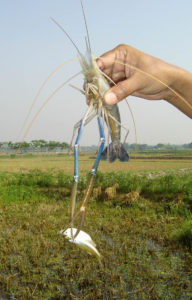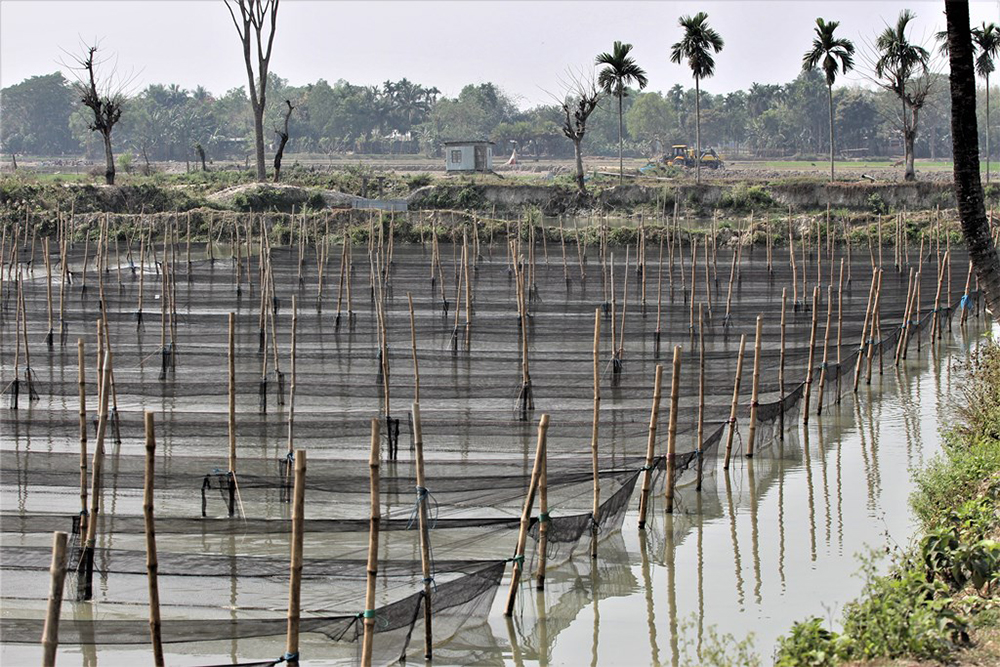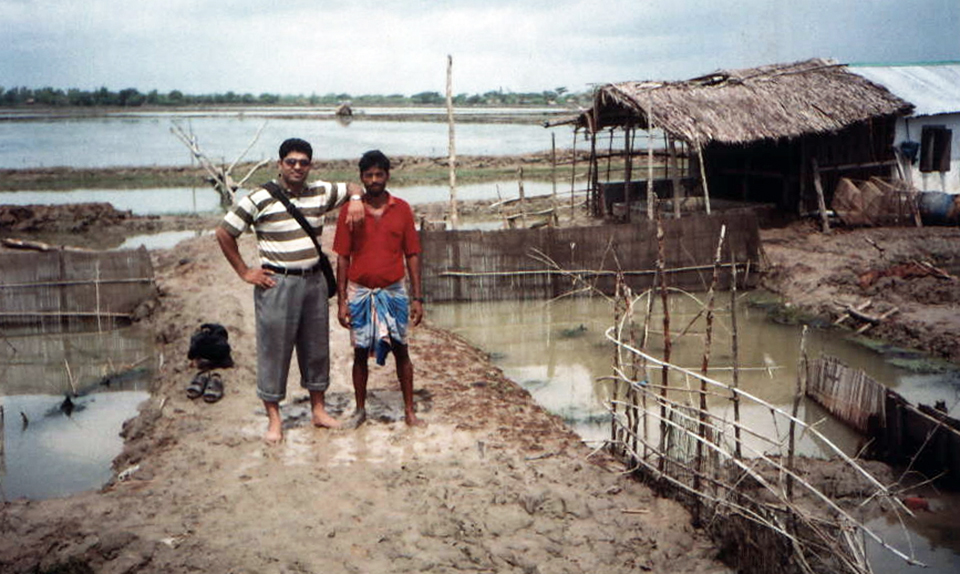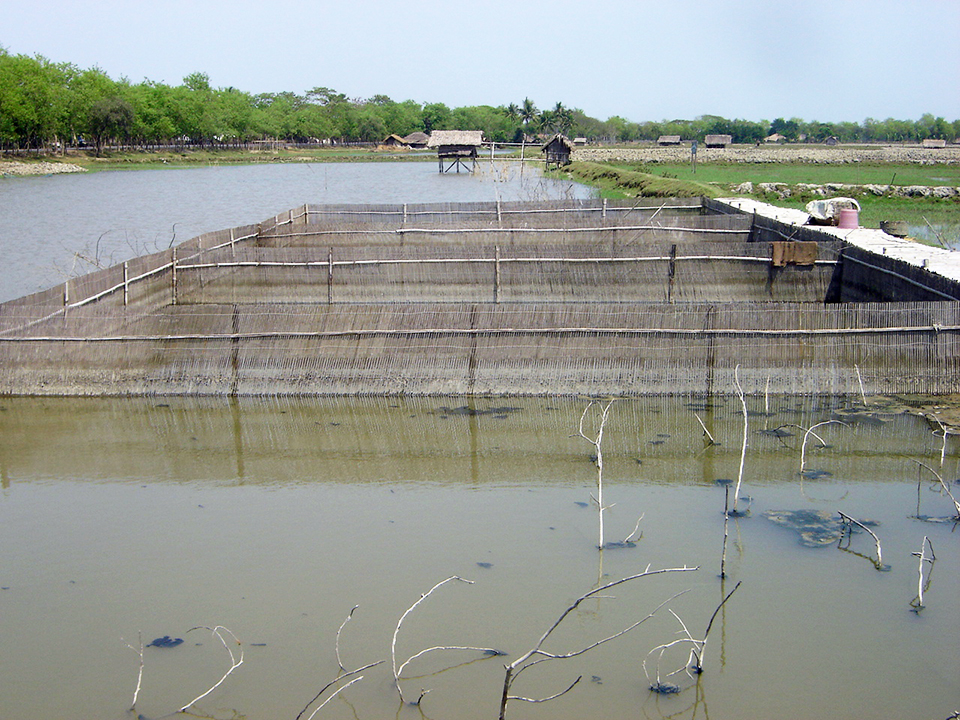Farming tilapia together with prawns may be an option

The culture of fish in cages is a promising aquaculture technology that has already proven itself in many Asian countries. However, cage culture is a relatively novel concept in Bangladesh, with a brief and mostly unsuccessful history.
Cage culture was first introduced to Bangladesh in the late 1970s. A series of experiments were conducted by the Faculty of Fisheries, Bangladesh Agricultural University, and Bangladesh Fisheries Research Institute. The Department of Fisheries also conducted a cage culture project in Kaptai Lake during 1985 and 1986. The largest cage culture project, Cage Aquaculture for Greater Economic Security, was initiated by CARE Bangladesh in 1995 until 2000.
Despite successfully demonstrated technology and a considerable number of people trained through various projects, cage culture has yet to be widely adopted.
Cage culture
Cage culture has advantages over other aquaculture systems that are potentially important in terms of uptake by rural poor and landless people. Traditional aquaculture in Bangladesh has focused on pond systems that necessitate the ownership of a water body. However, a large number of landless poor do not have access to ponds. The integrity of the cage unit means that large, communal water bodies including rivers can be used.
Bangladesh is called a “land of rivers,” as the country is crisscrossed with a network of around 700 rivers and tributaries totaling 24,140 km. River fisheries in Bangladesh are characterized as “open-access” and “common-pool resources.” Hence, where access to a river can be achieved, landless people and poor fishers can grow fish in cages for food and income.
Freshwater prawns

Although farming of freshwater prawns (Macrobrachium rosenbergii) in cages is a new concept in Bangladesh, many Asian countries including the Philippines, Thailand and Vietnam have found success with it. Bangladesh is considered one of the most suitable countries in the world for prawn culture in ponds and rice fields, because of its favorable resources and agroclimatic conditions.
Prawn farming is currently one of the most important sectors of the national economy, and during the last three decades, its development attracted considerable attention for its export potential. In 2007-2008, Bangladesh exported 49,317 metric tons of prawns and shrimp valued at U.S. $445 million, of which around 25 percent was contributed by prawns. A large number of rural poor are associated with prawn farming in southwest Bangladesh.
A major constraint to the development of prawn cage culture by poor communities is the lack of technologies appropriate to their social, economic and environmental context. Although the Department of Fisheries has been keen to respond to the opportunity for tilapia cage culture development, Intercooperation Bangladesh, a Swiss foundation, is beginning to show interest for prawn cage culture.
In association with Bangladesh Agricultural University, Intercooperation Bangladesh has initiated a feasibility study to establish prawn cage culture in the Sunamganj area of northeast Bangladesh. The aim of this study is to develop prawn cage culture in rivers to benefit resource-poor fishers and landless people.
Field assessment
A field survey was recently conducted by the author to assess prawn farming in cages on the Surma River in the Sunamganj area. After a reconnaissance survey, the specific site was selected on the Surma River and its surrounding tributaries. The Surma River is a major river in Bangladesh, part of the Surma-Meghna River system. The average depth of the Surma River is 86 meters.
Field data were collected through focus group discussions with fishers, landless poor and day laborers, including women, on the banks of the Surma River and in fishers’ houses. A total of 121 people were conducted through 10 discussion sessions, where each group consisted of 10-15 persons, and the duration of each session was approximately an hour.
Focus group discussions were used to get information on the attitudes of people regarding prawn cage culture, its possible constraints, socioeconomic benefits and environmental issues. Cross-check interviews were conducted with 15 key informants, including government fisheries officers, researchers, policy makers and non-governmental organization workers.
High interest
Most respondents were keen to get involved with prawn cage culture, because prawns are high-value fish. It is reported that the current local market price for prawns (U.S. $4-6/kg) is four to five times higher than those for Indian major carp or tilapia.
Moreover, fishers reported that their income from fishing has fallen due to declined catch because of overfishing, use of destructive fishing gear, environmental degradation, siltation and human encroachment. On the other hand, fishers suggested that cage culture may require relatively modest investment, as cages can be made locally with available bamboo and netting.
Culture planning

A 120-day culture period was planned for the growout of prawns in cages. In general, longer culture periods produce larger prawns that may get higher market prices. Nevertheless, two production cycles per year – from April to November – were recommended to get higher economic returns.
It was planned to stock large juveniles in order to maximize the growing season, and hence increase production as well as profit. Prawn juveniles can be purchased from prawn hatcheries, mostly located in southwest Bangladesh.
Higher production of prawns in cages can be achieved if commercial feeds are used. However, a complete pelleted diet may not be affordable for resource-poor fishers. In these cases, locally available feed ingredients including rice bran, wheat bran, mustard oil cake, and fishmeal can be used. Snail meat is widely applied as shrimp feed in southwest Bangladesh, where farmers obtain higher prawn yields and lower production costs than when using homemade feed.
Other aspects of prawn cage culture, including cage setup, stocking procedures, feeding schedule and partial harvesting of larger prawns were planned. Moreover, care of cages – cleaning of aquatic weeds, waste feed and deposited silt; removal of water hyacinths; checking cage frames and feeding trays; and monitoring of water quality – were proposed. It was also thought to consider prawn health and disease monitoring throughout the culture period.
Constraints
Despite the planning for prawn cage culture, a number of constraints were reported, including floods, heavy rain, inadequate supply of juveniles and disease. On a trail basis, a number of cages were set up on the Surma River. However, a sudden flash flood from the hilly region affected all cages. Every year the Surma floods leave thousands of fishers homeless. It is therefore recognized that prawn cage culture on the Surma River may be impossible.
According to key informants, the floods deteriorate water quality significantly and increase water turbidity, which may not be suitable for prawn farming in cages. Most also suggested that diseases may be an important issue for prawn culture in cages. Moreover, supply of adequate prawn fry from a long distance is difficult. With these views, all key informants suggested that prawn cage culture may not be suitable in the present context of Bangladesh.
Future prospects
Despite the success of prawn cage culture in many Asian countries, Bangladesh is still behind in this opportunity. Nevertheless, small-scale tilapia culture in cages has been successful in some places of Bangladesh. Farming tilapia together with prawns in cages may be an option.
Since tilapia and prawns belong to different food niches, they can live together without competing for food, and thus it would be possible to get higher yields without increasing the amount of feed. However, concern may arise about the sustainability of cage culture. It is suggested that any initiatives to promote cage aquaculture must consider social, economic and technological aspects along with environmental capacity.
(Editor’s Note: This article was originally published in the November/December 2010 print edition of the Global Aquaculture Advocate.)
Now that you've reached the end of the article ...
… please consider supporting GSA’s mission to advance responsible seafood practices through education, advocacy and third-party assurances. The Advocate aims to document the evolution of responsible seafood practices and share the expansive knowledge of our vast network of contributors.
By becoming a Global Seafood Alliance member, you’re ensuring that all of the pre-competitive work we do through member benefits, resources and events can continue. Individual membership costs just $50 a year.
Not a GSA member? Join us.
Author
-
Nesar Ahmed, Ph.D.
Department of Fisheries Management
Bangladesh Agricultural University
Mymensingh 2202, Bangladesh[109,111,99,46,111,111,104,97,121,64,48,48,48,50,95,114,97,115,101,110]
Tagged With
Related Posts

Intelligence
Bangladesh’s tilapia aquaculture industry shows resilience
Tilapia aquaculture in Bangladesh has developed significantly since 1999, based on the Genetically Improved Farmed Tilapia (GIFT) strain of Nile tilapia (Oreochromis niloticus) introduced from Malaysia and on the significant genetic improvement research work by the Bangladesh Fisheries Research Institute (BFRI).

Intelligence
Evolution of shrimp farming in Bangladesh
The social and environmental improvements – in combination with job-generating foreign investment – have led to wide acceptance of shrimp farming in Bangladesh.

Responsibility
Coastal aquaculture in Bangladesh must adapt to climate change
Shrimp culture in coastal Bangladesh is threatened by climate change variables that include flooding, cyclones, drought, salinity changes and rising sea levels. Holistic planning can help reduce the impacts.

Health & Welfare
10 paths to low productivity and profitability with tilapia in sub-Saharan Africa
Tilapia culture in sub-Saharan Africa suffers from low productivity and profitability. A comprehensive management approach is needed to address the root causes.



